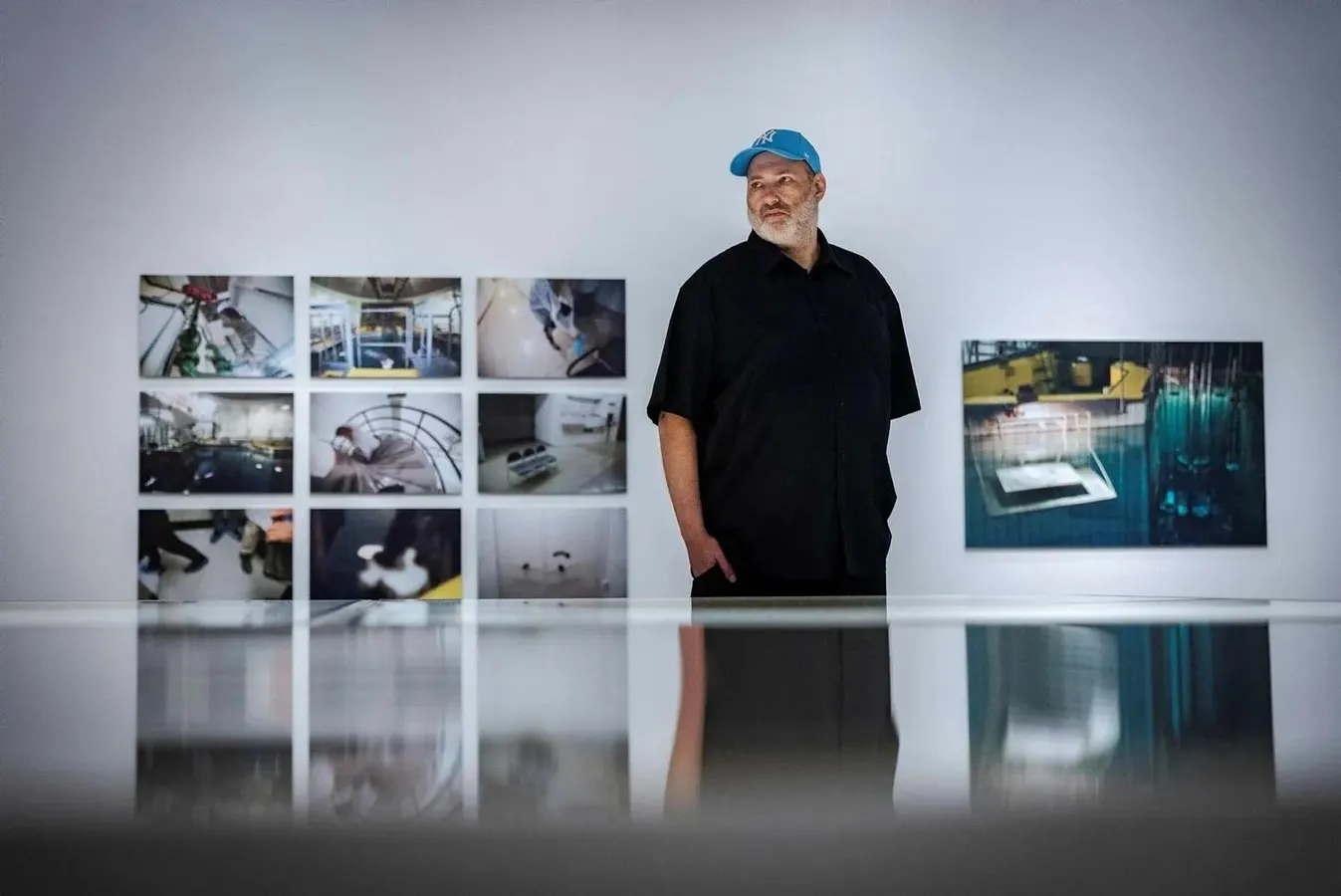Copyright forbes

Tomer Ganihar at the Israel Museum, Jerusalem Olivier Fitoussi for Haaretz newspaper Hitler’s bathtub features in a famous self-portrait by war correspondent Lee Miller, who sits comfortably wiping down one shoulder, her muddy boots on the dictator’s bathmat. Taken in 1945 on the day of Hitler’s suicide, it’s one of the definitive images of the end of WWII, showing how Allied forces hadn’t just entered Hitler’s lair but made themselves at home in it. “I did a tribute to Lee Miller,” says American Israeli photographer Tomer Ganihar, “I, too, shot myself in a bathroom—a selfie! The first in my career.” The bathroom he’s speaking of is in the Glass House, an iconic Modernist masterwork in New Canaan, Connecticut, designed by celebrated architect Philip Johnson. He was the founding director of the Architecture Department at MoMA, and the first recipient of the Pritzker Architecture Prize. But while he was the darling of the East Coast’s intellectual set, he was no ordinary scholar-artist. Johnson may have lived in the Glass House until his death in 2005, but those see-through walls didn’t stop him concealing his greatest secrets. Even now, few know that Johnson was a Nazi sympathizer. “I dedicated ten years of my life to studying the legacy and history of Philip Johnson. It’s the first time anyone dared deal with his dark side,” says Ganihar. The resulting body of work was shown in Jerusalem’s Israel Museum from June 2024 to February 2025, titled, Tomer Ganihar/Philip Johnson: Transparent Secrets. Curated by long-time friend and supporter, Robert Storr, the show centered on Ganihar’s photography of two key Johnson buildings: the see-through Glass House and top-secret Soreq Nuclear Research Center, alongside supporting evidence like Johnson’s sketches and recently recovered correspondence dealing with his fascist activities. Sketch of nuclear reactor by Philip Johnson Amnon Rechter Architects Firm and the Israel Museum Tomer Ganihar/Philip Johnson: Transparent Secrets at the Israel Museum For a show about dualities, Ganihar and Johnson are aptly the antithesis of each other. If Johnson represented the establishment, self-taught Ganihar rip-roars through the cliquish art world ("I’m an Israeli punk!” he proclaims). And yet, despite pushing hard against boundaries, Ganihar never sacrifices beauty in his search for truth. His career started unexpectedly; when serving in the IDF he used to escape his military base to party in the desert. There, he found a phalanx of Israeli youth who’d imported techno from the Goa rave scene and were reinventing it in the Holy Land. “I stole a camera from my base,” he shares, “this was a new counterculture, and I knew it was going to be big.” Catapulted to fame (and onto collectors’ walls) by this first brush with image-making, Ganihar decided to move on. “When everything is going well, that’s your cue to stop. I needed a challenge. Something tough.” While he was casting around for this new project, Ganihar’s uncle, an architect, passed away. On top of a pile of books he left was one about Philip Johnson. “My uncle was mysterious, elusive, a snob,” remembers Ganihar, “that’s what architecture was to me.” From the age of four, Ganihar had heard the whispered story of Johnson’s building in Israel, a nuclear plant that Johnson called “my temple in the desert”. It was apparently Johnson’s favorite design, and yet he’d never been allowed to see it completed. “A top-secret nuclear reactor that nobody has been allowed to visit? Now that’s a challenge!” thought Ganihar. Soreq nuclear reactor's model. Photographer unknown. Copyright held by Israel Museum The Glass House by Tomer Ganihar The Israel Museum’s exhibition, which brings together nearly three decades of work and “profound” research, dissects binaries: conceal-reveal, transparent-opaque, good-bad. In exploring the Glass House, Ganihar excavates beneath Johnson’s carefully curated image. Living with transparent walls that passers-by can peek into seems a radical way to prove you have nothing to hide. Yet Johnson was concealing his homosexuality, as well as how fascism enthralled him (he described a Nazi rally he attended in Germany as “exciting”). And despite the Glass House’s seeming promise of openness and accessibility, it’s surrounded by so much private land that no one could approach uninvited or unexpected. The Glass House by Tomer Ganihar Tomer Ganihar Soreq Nuclear Research Center by Tomer Ganihar Meanwhile, the Soreq Nuclear Research Center is one of Israel’s most obscured buildings: even planes are not allowed to fly over it. “This is hush-hush stuff,” says Ganihar, “for fifty- five years they’ve been blocking access to artists, thinkers, scholars, researchers, you name it. Everybody asked me why I thought I’d be the one to get permission,” here Ganihar pauses, “And I answer, because I’m one stubborn Jew!” When it came to the shoot, his descriptions are straight out of a spy film. Picked up by government personnel in black suits and sunglasses, even his camera was taken apart. But for Ganihar, this was ecstasy, “You have to understand, I’d been hearing about this building since I was four.” He takes a breath and continues, “This is the Atlantis of modern architecture—everybody knows something about this building but nobody has ever seen it. And... it’s breath-taking. I was hysterical, it was gorgeous.” Soreq Reactor by Tomer Ganihar Tomer Ganihar “Of course,” Ganihar continues, “I knew there was something problematic going on. I was admiring the work of a Nazi! Yes, I already knew all about Johnson.” The project may have unwittingly started with his architect-uncle, but Ganihar’s themes are universal. And as much as he “loves rocking the boat”, Ganihar’s outsize persona conceals a real thinker who turns his intellect into an excavating force. He illuminates what others have interred. Containing Complexity in Artistic Dialogue Ganihar understands he is dealing with dark topics. “It’s a hot potato! We have a Nazi architect, we have a nuclear reactor, we have racism, a lot of money involved. Big legacies and big questions.” There are many layers of human hypocrisy in this story: for a start, why would Johnson accept a commission in Israel if he was an antisemite? Furthermore, a significant amount of Philip Johnson’s supporters were wealthy Jews who knew of his predilections and who stood by while Johnson faced no repercussions in his lifetime for these views. Ganihar does not shy away from any of these conversations. Nuclear Reactor Indoors by Tomer Ganihar Tomer Ganihar As an audience, it is tempting to ask: why would a white upper middle-class person with a happy childhood, like Johnson, make these choices or develop these inclinations? “My mission was to deliver this to the public, we have to talk!” Ganihar explains, “I believe photography can tell the truth. It’s all about dialogue.” The last thing Ganihar wants is to “cancel” Johnson or obscure him from history. His method is to crack things open and let the world judge. Because of this, he has been willing to weather countless hurdles, from museums backing out of planned shows, to state censorship of the material. As such, he is particularly grateful to his curator, Robert Storr, whom he calls “legendary” and “wise”, and who gave him the courage to persevere with the project. Tomer Ganihar with the President of the State of Israel Shimon Peres at the Peres Center for Peace in Jaffa, Tel Aviv. Copyright with Tomer Ganihar. Despite what he’s been up against, and despite his personal feelings as an Israeli, Ganihar refuses to engage in blanket condemnation, or in forcing other people to see his world view. “I am a grow-up, I am not a child. I can contain complexity.” It is so fitting that this article comes close on the heels of the ceasefire, just as Miller’s famous bath photo was taken the day Hitler and his wife committed suicide. This is undoubtedly a brave body of work and would have been too risky for many to touch. But Tomer Ganihar, as a firebrand and outsider, was ready to penetrate the home of the enemy and make it his own. Editorial StandardsReprints & Permissions



